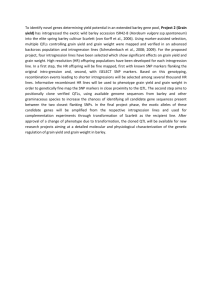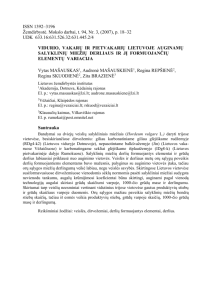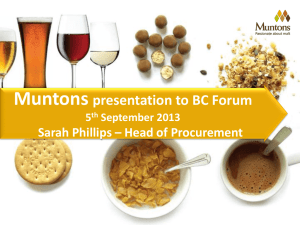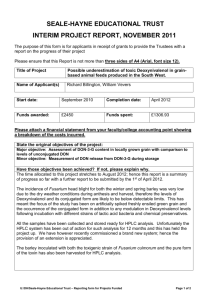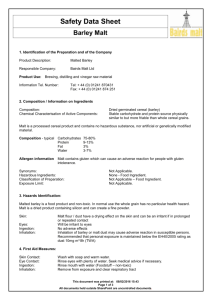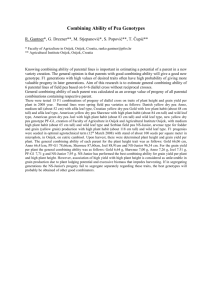environmental effects on grain yield and malting quality parameters
advertisement
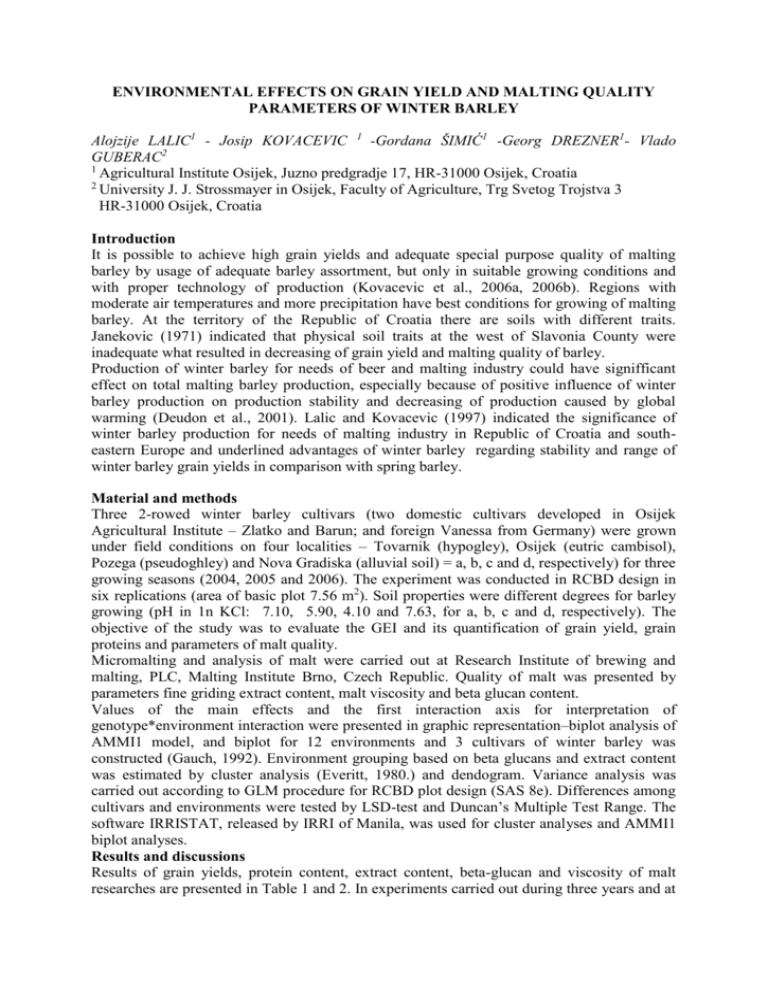
ENVIRONMENTAL EFFECTS ON GRAIN YIELD AND MALTING QUALITY PARAMETERS OF WINTER BARLEY Alojzije LALIC1 - Josip KOVACEVIC 1 -Gordana ŠIMIĆ1 -Georg DREZNER1- Vlado GUBERAC2 1 Agricultural Institute Osijek, Juzno predgradje 17, HR-31000 Osijek, Croatia 2 University J. J. Strossmayer in Osijek, Faculty of Agriculture, Trg Svetog Trojstva 3 HR-31000 Osijek, Croatia Introduction It is possible to achieve high grain yields and adequate special purpose quality of malting barley by usage of adequate barley assortment, but only in suitable growing conditions and with proper technology of production (Kovacevic et al., 2006a, 2006b). Regions with moderate air temperatures and more precipitation have best conditions for growing of malting barley. At the territory of the Republic of Croatia there are soils with different traits. Janekovic (1971) indicated that physical soil traits at the west of Slavonia County were inadequate what resulted in decreasing of grain yield and malting quality of barley. Production of winter barley for needs of beer and malting industry could have signifficant effect on total malting barley production, especially because of positive influence of winter barley production on production stability and decreasing of production caused by global warming (Deudon et al., 2001). Lalic and Kovacevic (1997) indicated the significance of winter barley production for needs of malting industry in Republic of Croatia and southeastern Europe and underlined advantages of winter barley regarding stability and range of winter barley grain yields in comparison with spring barley. Material and methods Three 2-rowed winter barley cultivars (two domestic cultivars developed in Osijek Agricultural Institute – Zlatko and Barun; and foreign Vanessa from Germany) were grown under field conditions on four localities – Tovarnik (hypogley), Osijek (eutric cambisol), Pozega (pseudoghley) and Nova Gradiska (alluvial soil) = a, b, c and d, respectively) for three growing seasons (2004, 2005 and 2006). The experiment was conducted in RCBD design in six replications (area of basic plot 7.56 m2). Soil properties were different degrees for barley growing (pH in 1n KCl: 7.10, 5.90, 4.10 and 7.63, for a, b, c and d, respectively). The objective of the study was to evaluate the GEI and its quantification of grain yield, grain proteins and parameters of malt quality. Micromalting and analysis of malt were carried out at Research Institute of brewing and malting, PLC, Malting Institute Brno, Czech Republic. Quality of malt was presented by parameters fine griding extract content, malt viscosity and beta glucan content. Values of the main effects and the first interaction axis for interpretation of genotype*environment interaction were presented in graphic representation–biplot analysis of AMMI1 model, and biplot for 12 environments and 3 cultivars of winter barley was constructed (Gauch, 1992). Environment grouping based on beta glucans and extract content was estimated by cluster analysis (Everitt, 1980.) and dendogram. Variance analysis was carried out according to GLM procedure for RCBD plot design (SAS 8e). Differences among cultivars and environments were tested by LSD-test and Duncan’s Multiple Test Range. The software IRRISTAT, released by IRRI of Manila, was used for cluster analyses and AMMI1 biplot analyses. Results and discussions Results of grain yields, protein content, extract content, beta-glucan and viscosity of malt researches are presented in Table 1 and 2. In experiments carried out during three years and at four locations, cultivars Barun (6,431 t/ha) and Zlatko (6,878 t/ha) resulted with statistically similar grain yield, and significantly higher in comparison with cultivar Vanessa (5,765 t/ha). Statistically justified differences in grain yield and protein content of barley grain were detected among years. Location Osijek had higher grain yield than locations Pozega, Nova Gradiska and Tovarnik. Table 1. Means for grain yield and protein content Grain yield, t ha-1 Protein content, % Year Locality Zlatko Barun Vanessa Mean Zlatko Barun Vanessa Mean 2004. 7.035 6.952 5.369 6.452 b 13.50 12.88 14.33 13.57 a 2005. 6.097 6.036 4.711 5.615 c 12.85 12.60 13.57 13.01 b 2006. 7.502 7.805 7.216 7.507 a 11.70 11.40 11.94 11.68 c LSD 5% 0.252 0.21 Osijek 8.453 8.845 6.604 7.967 a 12.45 12.08 14.14 12.89 b Nova Gra d. 6.059 6.422 5.652 6.044 b 11.96 11.71 11.99 11.89 c Požega 6.626 6.264 5.423 6.104 b 12.84 12.51 13.53 12.96 b Tovarnik 6.375 6.193 5.382 5.983 b 13.47 12.89 13.46 13.27 a LSD 5% 0.291 0.24 Mean 6.878 a 6.931 a 5.765 b 6.525 12.68 b 12.30 c 13.28 a 12.75 LSD 5% 0.252 0.21 “a...d” - Duncan’s Multiple Range Test at P≤0,05 Table 2. Parameters of malt quality Viscosity 8,6 % Locality Extract fine grind., % Cultivar 2004 2005 Mean 2004 2005 Mean Osijek 79.37 78.73 79.05ab 1.816 1.579 1.697 a Nova Gradiska 78.03 79.33 78.68 bc 1.620 1.593 1.606 b Pozega 79.87 79.60 79.73 a 1.659 1.518 1.589 b Tovarnik 76.47 79.67 78.07 c 1.696 1.516 1.606 b LSD 5% 0,70 0,051 Zlatko 78.07 78.80 78.44 b 1.826 1.625 1.725 a Barun 78.65 79.57 79.11 a 1.707 1.557 1.632 b Vanessa 78.58 79.62 79.10 a 1.560 1.472 1.516 c Mean 78.43 b 79.33 a 78.88 1.698 a 1.551 b 1.625 LSD 5% 0,49 0,61 0,036 0,044 “a...c”- Duncan’s Multiple Range Test at P≤0,05 Beta-glucans, mg/l 2004 1065 832 727 805 2005 Mean 724 895 a 469 651 b 286 506 c 252 528 bc 141 1196 599 897 a 880 450 665 b 496 250 373 c 857 a 433 b 645 99 122 The highest and statistically similar extract content was found at locations Pozega (79,73%) and Osijek (79,05%) (Table 2). Cultivars were significantly different regarding beta glucan content, malt viscosity and malt extract content. Cultivars Vanessa and Barun had similar level of malt extract. Cultivar Vanessa had significantly lower content of beta-glucan in malt and better results of malt viscosity than cultivars Zlatko and Barun. The absolute value of the first principal component (PC1) score represented the simplest measure of stability provided by AMMI analysis (Annicchiarico, 1997). A genotype can be considered more responsive to different environments when its PC1 score was large, either positive or negative. Cultivar Vanessa which had the lowest grain yield and the highest protein content in experiments had the highest interaction scores for mentioned traits. Location Osijek where grain yield was the highest and protein content above average during the three-year experiment showed different interaction scores for protein content from low (2006) to high (2004 and 2005). Regarding grain yield in 2004 and 2005 locations Osijek and Pozega had higher interaction scores than other localities. Cluster analysis of locations for content of fine grinding extract indicates grouping of localities with significantly lower influence of year (Graph 3). Analysis of beta glucan by cluster analysis indicates grouping of locations with significant influence of year (Graph 4). Location Osijek in 2005 for beta glucan trait makes individual cluster significantly different regarding the level of joining in comparison with other localities. On cluster dendogram that shows locations (Graph 3) grouping of environmets was detected regarding extract content, but not depending on year, for locations Nova Gradiska and Pozega and for locations Osijek and Tovarnik. Considering beta glucan content in malt there were three clusters of environments grouped, with significantly different locations Osijek and Nova Gradiska in 2005 than other locations. Location Osijek had much higher content of beta glucan (Table 2) than other locations, where tested barley varieties also had the highest malt viscosity. Between 2004 and 2005 significant differences were estimated in beta glucan content as well as significant (P≤0,05) differences among cultivars and locations (Table 2). Passarela et al. (2002) pointed out the negative effect of high temperatures (8ºC above natural temperature of environment) on ear and grain forming, grain yield and grain malting quality as the result of increasing of beta-glucan, protein and decreasing of malt extract. At location Osijek, in both years of testing, the highest content of beta-glucan in malt was found. The content of beta glucan in malt is connected with malt viscosity, and high correlations between mentioned traits are highlighted in literature. Shakhatreh et al. (2001) indicated that lasting of the grain filling period in terms of favorable humidity has positive effect on grain yield, but in drought conditions genotypes with longer period of vegetation gave much lower grain yields. In our investigations the mentioned effect was found in cultivar Vanessa which in our experiments started earing up 7 to 10 days later than cultivars Barun and Zlatko. Conclusions Conducted researches showed significant effect of cultivar and environment on grain yield and malting quality of barley. Barun is cultivar with the highest grain yield and very good indicators of protein and malt extract content. Vanessa had lower grain yield than cultivars Barun and Zlatko, higher protein content in grain but the best indicators of malt extract, malt viscosity and beta-glucan. Cluster analysis of malt extract content indicated grouping of locations Nova Gradiska and Pozega as well as Osijek and Tovarnik, which did not depend on year. Significant differences were found for beta glucan content between years and locations of testing, and particularly inadequate beta glucan content was found at Osijek and Nova Gradiska locations in 2005. References Annicchiarico P.: 1997. Joint regression vs AMMI analysis of genotype-environment interaction for cereals in Italy. Euphytica 94 53-62 pp Everitt, B.:1980. Cluster analysis. London, Heinemann educational books Janeković Đ.: 1971 Pedološke karakteristike Slavonije i Baranje, Zbornik Radova Prvog znanstvenog sabora Slavonije i Baranje. 17.-19 pp Kovacevic V. -Banaj D. -Kovacevic J. -Lalic A. -Jurkovic Z. -Krizmanic M.: 2006a. Influences of liming on maize, sunflower and barley. Cereal Research Communic. Vol. 34 no. 1 553-556 pp Kovacevic J.-Lalic A. -Kovacevic V.-Banaj D.: 2006b. Respons eof barley to ameliorative fertilization. Cereal Research Communications vol. 34 no. 1 565-568 pp Lalić, A.- Kovačević J.: 1997. Oplemenjivanje ječma za potrebe sladarstva i stočarstva u Republici Hrvatskoj. Poljoprivreda , no 3 31-45 pp Narzi L.: 1976. Technologie der Malzbereitung, 6th ed., f.-Enke-Verlag, Stutgart. Passarella V.- Savin R.- Slafer G.: 2002 Grain weight and malting quality in barley as affected by brief periods of increased spike temperature under field conditiona. Australian Jurnal of Agricultural Research, no 53 11 1219-1227pp Shakhatreh Y.- Kaffavin O.- Ceccarelli S.- Saoub H.: 2001. Selection of barley lines for drought tolerance in low-rainfall areas. Journal of Agronomy. no 186 2 119-127 pp SAS : 1998. SAS Online doc V7. SAS institute Inc., Cary, NC.
